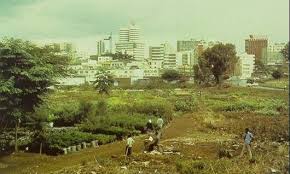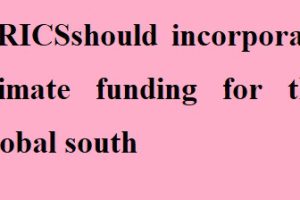
Urban agriculture utilizes resources such as land that have high demand for other urban uses. The economic relevance of urban agriculture in cities is being realized by city dwellers. Studies are being conducted to improve the understanding that urban agriculture contributes to the livelihoods of the urban society. These studies are becoming relevant as the rate of urbanization is becoming a threat to the developing countries. As T. F. Duressa pointed out many of the countries which experienced fast urban growths are mostly least-developed ones. These countries are “not” capable enough to provide sufficient food demanded by the expanding urban population.
The rural-urban migration is on the rise as people move to the towns in search of employment. This leads to increased food insecurity and prevalence of poverty in the urban areas. The urban population of Ethiopia has been projected to increase two folds in recent years (MOFED). Urban poverty is currently becoming a growing concern especially in large cities of the country. As D. Potts suggested, cities may need to consider agricultural production in urban areas or urban frontiers to “reduce” the food insecurity and prevalence of poverty. It is argued that urban agriculture is evolved as a response to insufficient supply of staple food to cities coupled with declining purchasing power of city dwellers.
Currently, millions of urban dwellers are forced to engage in urban farming throughout many African cities either to supplement their household income or to meet their daily food needs. Urban agriculture is not a phenomenon that is practiced only by urban people in African cities, including Ethiopian urban areas, as their survival strategy. It is also being practiced in the “developed” countries to supplement food imports. They obtain some of the agricultural produce from urban farmers and community horticulturists, growers and gardeners. Urban agriculture is important for reducing urban food insecurity and improving income of the urban poor in the developing countries.
Urban agriculture includes agricultural production of various kinds. The main subsectors are horticulture, floriculture, forestry, fishery, poultry and livestock mainly in public open spaces within cities and frontier or marginal areas. These agricultural activities use resources, products and services of the city area. These activities are efficient in using urban land for poverty alleviation, economic development and environmental management. As observed by E. Bryld, despite the emerging merits of urban agriculture, most of the urban agricultural productions are “not” used beyond subsistence consumption. Also, costs of inputs such as land, water, labor, machineries, chemicals, seeds, power, storage, and technical knowhow are considerable. These costs and waste produces may exceed the benefits.
On the supply side, the contributions of urban agriculture to sustainable provision of food to cities are valuable. Similarly, incomes generated from land, labor and capital used in urban agriculture generate “demand” for manufactured goods. This creates linkage between various sectors. However, this linkage may not be sustainable as the demand for land is high in other sectors such as construction. Urban agriculture has to compete with other sectors for labor. This situation casts doubt on the benefits of urban agriculture to the urban households due to high cost of “inputs” for production. Wage is high due to demand for labor in other sectors, particularly in construction. These sectors also compete for land.
Urban agriculture is widely practiced as an informal economic activity across many African cities. For D. Potts, urban agriculture is a viable activity to complement food supplies from rural areas to towns. It is a means of income generation for many of the urban poor. Urban agricultural producers are also often “discouraged” and ignored by the society and policy makers. Planners tend to think that urban food growing is messy business. They have little understanding of peoples’ need to grow food in the urban areas. This is because governments, international organizations, and researchers have no interest in the characteristics of urban livelihoods in the informal sector.
Donor agencies cutback their aid to African urban projects assuming that they are most favored by other financiers as compared to the rural projects in the past decades. But, as D. Potts suggested this assumption does “not” hold to the urban poor. The cutback in aid drove African cities, including Ethiopian cities, to stagnant economy and prevalence of poverty. Urban environment is more complex and diverse, and urban livelihoods are dynamic. Little progress is made without a better understanding of how urban dwellers run their livelihoods. It needs deeper understanding of how they cope with urban vulnerability. N. Hervey noted that though the urban poor endeavor to secure their food, little progress is made in improving their living standards. To alleviate such poverty, policy makers should give priority to urban agriculture as a remedial action.
It is reported that the poverty gap between the urban and rural areas is narrowing. But, this is “not” because the poverty in the rural area is reducing down to poverty levels in the urban areas. The reason for that is the “rise” in the number of urban people below the poverty line over time. The report also emphasized the unsatisfactory urban development policies as major reasons for rise in the urban poverty. The livelihoods of many urban citizens is heavily dependent on urban farming, but urban policy makers fail to give due attention to this sector. They do not realize that a large number of households whose livelihoods are associated with farming directly support thousands of families. These households also indirectly influence the lives of other parts of the urban society as in Ethiopia.
The role that urban agriculture plays in improving the livelihoods of urban poor people will definitely force policy makers to design better urban development programs and projects. These programs have to be based on studies related to urban economic problems particularly focused on the contribution of urban agriculture to urban livelihoods. These studies will provide information and knowledge about the role the sector plays in urban livelihoods. They will add information to the limited researches done so far on the role of urban agriculture in the country as a whole. The extent of urban agriculture and its impacts on the economy have to be “deeply” examined with focus on poverty alleviation.
Studies have identified and addressed the different factors that determine urban farming activities. Experts have explored the type of people who depend on income derived from urban agriculture with focus on poverty alleviation and better use of urban natural resources. They have identified what, how and when people want to produce. This is usually determined by the culture, tradition, markets, water supply, and rainfall; soil condition, plot size and distance to home are also important determinants. Family size, availability and location of land are critical determinants of the type of urban agriculture practiced. As T. Deelstra put it, urban agriculture covers subsectors mentioned earlier, mainly in open spaces within or on the borders of cities in which the urban poor are engaged.
Urban agriculture is considered as a sector that produces for urban markets to meet the demands of its dwellers. In Africa, including Ethiopia, cities are sprawling and continually engulfing the nearby villages, and hence, the farmers in the villages continue farming after being part of the cities. Understanding the nature and structures of these cities and setting “specific boundaries” is helpful for a common definition of urban agriculture. Within the boundaries of cities, it has unique features with distinct potentials and constraints. The “benefits” of cities from urban agriculture imply the contributions of the sector to the sustainability of cities. Studying urban agriculture from social, economic and ecological dimensions is helpful to realize the net benefits.
The potentials of urban agriculture are mainly realized in the open spaces, along river sides where land is not suitable for building construction. As E. Bryld put it, urban agriculture brings with it great potentials for the urban citizens, especially those with the lowest incomes who are dependent on access to locally grown food. Urbanization in the developing countries has been accompanied with increased demand for food. This demand has been on the rise by the increasing number of households that could just afford to buy enough food for their own consumption. Most of urban farming is practiced by the Ethiopian urban poor who consume most of the produce. They supply the market with what is left from their consumption.
The rest of the urban poor engaged in non-agricultural activities have to purchase their food from the market. The “major” expense for most of the urban poor is purchase of food, which assumes a large portion of their daily earnings. This leaves them with almost nothing for covering the cost of health, education, rent, and other necessities. They also hardly consume other varieties of food. Thus, it is not surprising that urban farming contributes to the small improvement of livelihoods for the rising number of the urban poor. It improves not only quantity of food intake but also the nutritional value if the poor could consume their produce of vegetables, fruits and chickens.
The contribution of urban agriculture to food security and healthy nutrition is probably its most important value. Food production in the city is in many cases a response of the urban poor to inadequate, unreliable and irregular access to food, and the lack of purchasing power. Urban farming can also be a good source of income for the urban poor, if it is especially practiced as a formal sector. However, it is highly doubted if it has a significant macroeconomic contribution such as foreign exchange through export of urban farm produces. Urban farming has an economic relevance because it is helping urban farmers, especially the poor, to use their non-farm income for other purposes.
It is true that urban farming improves the welfare of urban farmer households. In Ethiopia, urban dwellers benefit from cheap urban farm produces such as vegetables, particularly tomatoes, carrots, green-peppers, onions, garlic, etc. which are sold in the open markets and streets in and around villages. Usually, the producers “carry” these produces to corners where the urban dwellers have access for purchase. Sometimes, farmer-traders take their produce to the doors of urban dwellers and exchange them at bargain prices. Usually, the buyers are willing to offer only about half of the price quoted by the mobile trader. Both the buyer and the seller are poor people who try to make ends meet through cheap bargain. They may call it “poverty alleviation.” The concerned agencies have to devise realistic policies and programs that may alleviate the poverty of the urban working poor in Ethiopia.
BY GETACHEW MINAS
THE ETHIOPIAN HERALD MAY 27/ 2021




